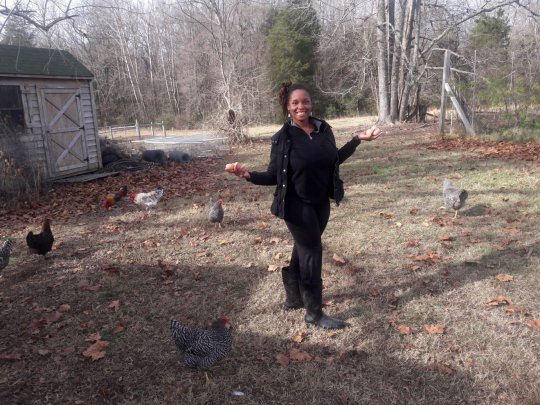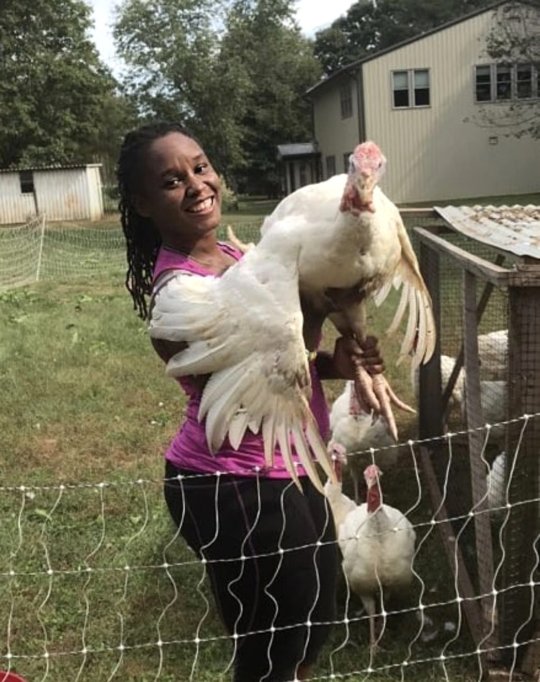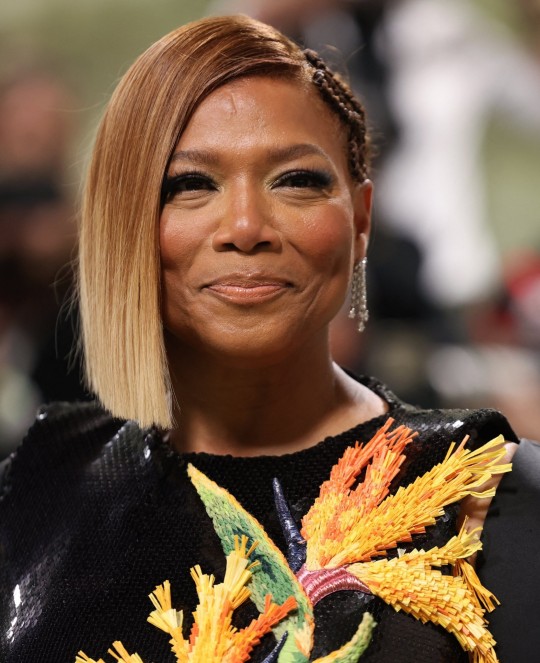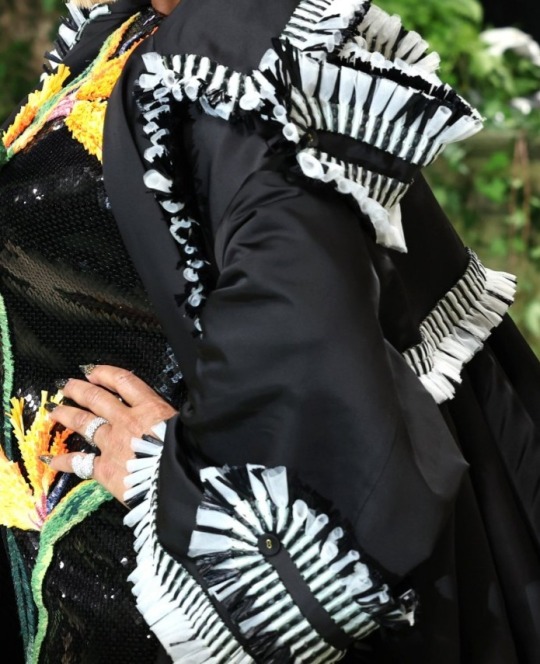#Black Women with Gardens
Explore tagged Tumblr posts
Text
The car made its way along a tree-lined gravel road. The sky was clear, and as the car drove by, the trees swayed from side to side, almost like a sign of welcome. The road opened up into a large pasture. In the middle of the pasture was a wooden pergola with grapes growing on it and a circular garden surrounding it. Tiny houses darted the pasture, as brown children played merrily in the mud. In the center of all of this, planting in the circular garden like she was Mother Earth herself, was a Black woman.
For Chantel Johnson, this scene was “heaven.” It was actually Bear Creek, North Carolina, in May 2016, but more importantly, it was Johnson’s first glimpse into homesteading, and she was hooked at first sight.
Johnson, an African-American woman in her late 20s at the time, made her way up the gravel road that day with her boyfriend, whom she’d met a few months prior on OK Cupid. Johnson was attracted to his profile picture: a shot of him standing with goats. She recalls thinking to herself, “Are those goats? I want to meet those goats!”

Chantel Johnson at her first homestead in Chatham County, North Carolina, 2016. Photo courtesy Chantel Johnson
Johnson was grieving and depressed. It had been less than a year since her younger brother, who had been shot and paralyzed on the South Side of Chicago in 2014, succumbed to his injuries and passed away, in August 2015.
She carried that grief with her up the gravel road that day to visit her boyfriend’s friends, an interracial couple — Black wife and white husband, with kids — who owned a 30-acre homestead in Bear Creek. When the friends offered Johnson and her beau the opportunity to live with them on the homestead and help out, Johnson jumped at the chance. If this was heaven, then perhaps she could find the antidote for her grief here.
One of the first official uses of the term “homesteading” was in 1862 with the passing of the Homestead Act, signed by President Abraham Lincoln to encourage western expansion and United States agricultural development. But the act of homesteading — a focus on self-sufficiency dependent on the land, with an emphasis on subsistence agriculture — predates the Homestead Act, especially for Black Americans.
Homesteading knowledge and skills allowed slaves to create a modicum of a life for themselves by growing their own supplemental food, raising small livestock and making needed tools and home goods. This same knowledge sustained Black families during the Reconstruction era and beyond. While there have been several resurgences of the self-sufficient homesteading mind-set in the United States, the face of these movements has been overwhelmingly white.
Meanwhile, Black people, and Black women in particular, have become the poster children for the antithesis of the values homesteading espouses. In contrast to self-sufficiency and hard work, Black women are stereotyped as dependent, disproportionately reliant on public assistance, and unwilling to work, perhaps most famously by former President Ronald Reagan’s racialized “welfare queen” remarks.
Black women also bear the brunt of many of our nation’s worst health outcomes, including high rates of obesity, high mortality from heart disease and breast cancer, and some of the worst maternal health outcomes and infant mortality rates. Only recently has the medical field started to acknowledge the role of trauma in facilitating these disparities.
Johnson recalls several layers of trauma from her childhood and young adult years. As a young girl growing up on the Southeast Side of Chicago, she remembers moments of joy and abundance contrasting starkly with moments of anger and scarcity, which flowed lockstep with the dwindling of the family’s financial resources from the first to the end of the month.
Then as an undergraduate student at a predominantly white university in the Midwest, she recalls being shunned by white and more affluent Black classmates alike, because she didn’t speak or behave the way they felt someone in that space should. She quickly learned to code-switch, alternating between ways of speaking and behaving based on her surroundings. It’s a practice that many Black people are all too familiar with, in their efforts to live, work and study in predominantly white environments.
She also struggled initially with coursework, attempting to translate her Chicago secondary education, where she graduated as salutatorian, to the rigors of university work. Johnson has conflicting feelings about the costs and benefits of her undergraduate education: “I was so fortunate to be at that school, where an institution had time to nurture me, but at the same time I was being traumatized and I was being changed. And that was a very difficult thing.”
Between 2012 and 2014, her middle brother and younger brother were each shot several times, but survived. The ultimate trauma was her younger brother’s untimely death, 15 months after he was shot in 2014.
Johnson received her bachelor’s degree, graduating cum laude, later earned a master’s degree and obtained a research job in North Carolina. But the impact of the trauma remained. Taken together, these experiences created a rage against “the system” in Johnson. She was angry about systemic racism and poverty and the laws, policies and institutions that uphold it.
“I’ve done everything right — star child, went to college, went to Africa for a few months, did AmeriCorps, I volunteered, I got this job, and I don’t understand why this isn’t enough and my brothers are being shot,” she says.
This revelation, four months prior to discovering Bear Creek, marked the beginning of Johnson’s homesteading journey. In her mind, self-sufficiency was the only option, because the system wasn’t going to take care of her. It was rigged.
Consequently, by the time she got her first glimpse of heaven, she was already intent on giving up her spacious two-bedroom townhouse in Durham, North Carolina — in exchange for less than 300 square feet of shared living space, with no electricity or plumbing, and an outside toilet. And to gradually transition from her research job, where she was miserable, in exchange for hard labor cultivating, raising animals and living off the land.
The transition came with other challenges as well. Johnson recalls initially being scared of the chickens she was tasked with putting back into their coops every night, having to rely on the assistance of a 5-year-old on the homestead for help. Also, after moving to Bear Creek permanently, two of the first homesteading tasks Johnson learned were chopping wood and lighting the wood-burning stove for cooking and heat. Two months later, Johnson found herself in the dead of winter, cold in the tiny house. Everyone else was away; she was alone and crying because she couldn’t light the wood-burning stove.
“That’s when I started to regret my decision,” Johnson remembers. But thankfully her cell phone still worked, so she found a YouTube video that walked her through lighting such a stove. Figuring out how to do it convinced her that maybe she could make it in this way of life. That she could bet on herself to succeed in spite of the odds.
While Johnson didn’t grow up with examples of homesteading around her as a child, for Aja Yasir growing your own food was always a normal way of life. Her parents were a part of the Second Great Migration: the period from 1940 to 1970 when Black people migrated from the South to Northern states en masse. Both of her parents brought the practice of subsistence agriculture with them to Chicago, purchasing a vacant lot next to their home in Englewood, on the South Side, to establish a home garden. They weren’t alone; other families in the neighborhood also had home gardens. For Yasir’s parents, the act of growing your own food was bolstered by 1960s and 1970s Black health messaging from the Chicago branches of the Black Panthers, the Nation of Islam, and Chicago-based Black public figures like Dr. Alvenia Fulton.
By the time Yasir was born, in the mid 1970s, growing food at home had become an established family tradition. A tradition that was almost broken when in her early adult years Yasir decided she wanted nothing to do with agriculture. Instead, she moved as far away from Chicago as she could, to pursue her bachelor’s degree in Atlanta. But a polarizing global figure would entice Yasir back to the land: Venezuelan President Hugo Chávez.

Four-year-old Aja Yasir at her parents’ garden in Chicago. Photo courtesy of Aja Yasir
It was late 2005, Yasir had returned to the Chicago area, completed a master’s degree, and was working at a local radio station. A colleague at the station shared an article about Chávez ousting an American missionary group, New Tribes, from Venezuela, accusing them of being imperialists and exploiting indigenous people. Yasir’s interest was piqued. Then, in 2006, she heard Chávez’s United Nations speech, in which he referred to President Bush as “the devil,” in protest of U.S. global domination. Yasir wanted to investigate the conflicting media images of Chavez — hero of the poor versus villain of democracy. So she left Chicago for Venezuela, with no Spanish and a flimsy local job prospect. She stayed in a town in Barlovento, a region with a large population of Afro-Venezuelans, known for its cocoa production.
Yasir still remembers how fresh everything tasted in Barlovento, and the prominence of locally grown and made food: “You cannot escape agriculture in that town because everybody is doing something involved with agriculture, whether it’s raising chickens in their yard, or growing bananas, or harvesting and making chocolate. Agriculture is just connected like that.” Barlovento made her appreciate her Englewood upbringing, rooted in urban agriculture.
Her reunion with the land would come to serve her almost a decade later.
Yasir considers herself to be someone with a lifetime of traumatic experiences, although she prefers not to retraumatize herself by going into detail about a lot of it. However, she did share about a recent anguish. In January 2016, her 3-week-old daughter, Yaminah, unexpectedly died, falling victim to a rare genetic condition. The cumulative effects of years of unresolved trauma, combined with losing a child, resulted in a complex array of mental health challenges.
A couple of months after the death of her youngest daughter, Yasir found herself driving around Gary, Indiana, with her husband, trying to decide if they could live there permanently. In 2015, the family had rented an apartment in Gary as a trial, prompted by the lower cost of living than the Chicago suburb where they’d previously resided. Now they wanted something of their own. But Gary had its challenges — hit hard by deindustrialization, white flight, racism and poverty. The city was blighted and grocery stores were scarce.
Yasir and her husband eventually found a house that had been abandoned for two decades in a less depressed part of Gary and decided to purchase it, under the expressed condition by Yasir that the only way she could live there is if she put a garden in. Shortly after purchasing the property, she mulched the entire front lawn with wood chips, a regenerative agricultural practice to enrich the soil, in preparation for her front yard garden.
To her surprise, her desire to do something as basic as grow food turned into a public battle with the city of Gary, which sent citations claiming that the wood chips in Yasir’s front yard were debris that was causing environmental problems in the neighborhood. “I didn’t realize that growing food was so abnormal until moving to Gary,” Yasir recalls. What the city of Gary didn’t know was that Yasir was prepared to fight back.
She wasn’t just fighting for her garden; she was fighting for her life.
“You don’t understand the grief that a mother goes through when she loses a child … I would not be able to manage the grief without the garden, and so that was the fight. We don’t have a connection to Gary, we don’t have any family here, the only connection to Gary we have is this garden and the garden is how I process grief … I’m fighting for my medicine.”
In 2019, Yasir sought the support of the Farm-to-Consumer Legal Defense Fund, signing up with them as a homesteader. They sent an attorney from California to represent her case against the city. In October 2019, Yasir won. Also, unrelated to her case, in 2019 Yasir’s home became a Certified Wildlife Habitat site with both the National Wildlife Federation and the Indiana Wildlife Federation. In order to be declared a Certified Wildlife Habitat, a garden or outdoor space must be maintained in a way that provides a sustainable environment for native animals and insects.

Aja Yasir and her husband Yasir Allah in her garden, which she named “A Rose for Yaminah.” Photo courtesy Aja Yasir
Yasir’s garden, perched against the backdrop of Gary, is an anomaly. A walkway leading to Yasir’s front door divides her front yard into two sides — food plants on the left and medicinal plants on the right. There’s a small retaining wall at the entrance of her yard, on either side of the walkway, to keep the wood chips off the common sidewalk area. Closest to the retaining walls, she plants edible flowers like roses, poppies and hibiscus, for beauty and pest management. On the left, you might find plants like Black Beauty tomatoes, red okra and Eritrean basil. On the right, she grows medicinal herbs like artemisia (also known as Sweet Annie). Around the back of her house, she has a burgeoning orchard with apple, nectarine, cherry and plum trees. She grows more than 200 species of plants, collects rainwater and makes medicinal teas. Her garden provides an invaluable part of her family’s diet. For example, they get 95 percent of their medicinal and culinary herbs and 100 percent of their leafy greens from the garden during the growing season. She named her garden “A Rose for Yaminah,” for her daughter who passed away.
Typically, Yasir doesn’t get to spend as much time in her garden and homesteading as she would like, finding moments in between homeschooling her daughter and managing her real estate business. And the results of her labor don’t always materialize quickly, which can be challenging. Yasir explains: “The hardest thing about this lifestyle is patience. I’m a regenerative gardener, which means I put a lot of work into soil health and biodiversity. Restoring balance to an ecosystem can be tough, especially when your family’s food is dependent on that ecosystem.”
Black women are becoming increasingly interested and visible in homesteading initiatives, as evidenced by the Facebook groups Sistas Who Can and Sistahs of Soil, which have Black female membership in the thousands. There has also been a recent upsurge in followers of homesteading Instagram pages led by Black women, like @thehillbillyafrican and @alysonsimplygrows.
Johnson and Yasir’s stories illustrate homesteading lifestyles catalyzed by mental health needs, but for others the health of the physical body is what leads them to homesteading. This was the entry point for Jacqueline Smith (who goes by Jackie), although in a way she’s been preparing to homestead for most of her life.
At the age of 9, Smith, also born and raised on the South Side of Chicago, was diagnosed with Type I diabetes. Her pancreas ceased to produce the vital hormone insulin, and Smith’s childhood was marked by strict dietary restrictions, daily insulin shots and frequent visits to the doctor. Having to deal with the illness as a child made Smith bookish, by her own description, and reserved.

Jacqueline Smith teaches a young Black girl gardening at her garden in Chicago. (Photo courtesy Jacqueline Smith)
As a teenager, she attended Chicago High School for Agricultural Sciences, not because she was interested in agriculture (in fact, the opposite was true at the time) but because her mother thought that the school would offer her a better education, due to its small student numbers and selective entry process. By the time she finished high school, Smith had developed a true interest in agriculture and was offered a full scholarship at a Midwestern university where she pursued a Bachelor of Science in agricultural economics.
While on campus, she was often assumed to be an African-American studies major. Her interest in agriculture was frequently questioned by her largely white, male classmates, from America’s breadbasket states, who were perplexed as to why a Black woman wanted to learn about agriculture. She met their curiosity with her own questions: “Well, why not? Why can’t I learn this?” She never received a compelling response.
The beginning of her undergraduate studies also marked Smith’s diagnoses with a second chronic illness, gastroparesis. After finishing her degree and while working at a corporate job back in Chicago in 2006, the stress of her illnesses sent her into a three-day coma. When she awoke from the coma in the hospital, she knew she had to make a change, but she wasn’t sure what or how, so she pursued a master’s degree in public service while she figured it out.
After earning her master’s degree, she developed an itch to garden. She also started to have recurrent dreams of being pregnant, although she was not. The gardening itch, combined with the increased challenges of managing her health needs while working a structured and stressful 9-to-5, led her to quit her job and become a full-time homesteader. In 2018, she started an agricultural consulting business, GrowAsis, helping clients design, plan and maintain their own garden oasis. When she “birthed” her business and new life, she ceased to have the pregnancy dreams.
Smith lives in Roseland, on the far South Side of Chicago. A typical day involves waking up early in the morning, slipping on her denim overalls, grabbing the chicken feed from her garage, and heading to her backyard to tend to her chickens. She has a total of 11 hens that she keeps for egg production. She usually gives them a small snack of split peas or flaxseeds to eat while she cleans their coop. Their manure is collected and stored for later use in her garden beds. She then turns her compost bin before checking on the status of her vegetable and herb plants.

Jacqueline Smith holding some produce from her garden in Chicago, 2016. Photo courtesy Jacqueline Smith
Smith designs her homesteading activities to support her dietary and health needs. During the growing season, Smith estimates that she can produce approximately 80 percent of the food she consumes from her garden and chickens. During the 2019 polar vortex, Smith didn’t go to the grocery store for two months, because she had enough food stored from her garden that she had either frozen or canned herself.
Homesteading with two chronic illnesses is challenging for Smith. When her illnesses flare up, it can halt her productivity for days at a time. She’s had to learn to rely on fellow farming friends to step in during these times to help her keep her homestead afloat until she recovers. By doing this she’s built a community, a village, that supports her.
Chantel Johnson has since moved on from Bear Creek, North Carolina, leaving behind that heaven, in search of one that is her own. The challenge is that Johnson is a landless homesteader, renting land to carry out her homesteading activities. She’s moved a total of four times since Bear Creek due to disadvantageous changes in the rental conditions or increasingly intractable rental relationships with the landowners — when you don’t own the land, you’re at the mercy of those who do. Her relationship with her boyfriend dissolved after move number two.
Despite the challenges, with each move Johnson has been able to expand her operations. She and her boyfriend in Bear Creek started off with 25 hens for egg production, and then added a few pigs, chickens for meat and turkeys. When their relationship dissolved, Johnson kept the animals and continued to add to her livestock progressively. She eventually decided to abandon agriculture and focus exclusively on livestock, due to the frequent moves, as it’s hard to transport crops from one place to another.
As of this writing in July 2020, Johnson is no longer fully off grid, residing on a farm in Chatham County, North Carolina, with a little more living space and a few more creature comforts. She has come a long way from the newly minted homesteader of Bear Creek. She currently has 500 chickens she raises for meat, a significant increase over last year’s stock, due to the high demand for chicken during the coronavirus pandemic. She also has eight pigs that she recently learned to butcher herself, instead of outsourcing them for processing. She plans to raise 125 turkeys this year for the holidays. She sells her sustainably raised meat at local farmers markets or direct order to customers. Amazingly, this is largely a two-person operation, with Johnson and her current boyfriend, who owns some of the land she farms on, as an employee.

Chantel at her homestead in North Carolina, holding one of the 120 turkeys she raised for the holiday season.Photo courtesy Chantel Johnson
Homesteading still plays an integral part in managing her mental health needs, having experienced several ups and downs throughout this four-year journey. Johnson characterizes the first part of her homesteading journey as being about survival — proving that she could survive in this lifestyle. Now, she is determined to make the second half of her journey about thriving. It’s a sentiment shared by Yasir and Smith as well — the intention not just to survive, but thrive.
Beyond this shared intention, these women’s stories are connected in their origins — experiences with trauma as Black women in the U.S. and a decision to return to the land for healing — sisters of the soil, victors of their destiny.
Shanna B. Tiayon is a social psychologist, freelance writer and speaker. Her work focuses on topics of well-being and the ways we may infringe upon the well-being of others. She’s a TEDx speaker and 2020 Best American Travel Writing award winner. When she’s not working in the area of well-being, she’s homesteading with her family — gardening, preserving food and composting.
#Black History Month 2023#Black Women#Black Women with Gardens#Black Women Homesteaders#Black folks growin food#Black folks Gardening#The New Sisterhood of Black Female Homesteaders
13 notes
·
View notes
Text










Not be to be one of those people, but life improved significantly once I started to exercise consistently, and I became more intentional with what I ate. My health became a priority, and everything started to align again.
Love it or hate it, it makes such a huge difference. Make your well being your highest priority and life will start to flourish in unexpected ways 🤍
#bae’s random thoughts#the garden of bae#black femininity#I aspire to be hot forever so I have no choice but to take care of myself#black women in luxury#black girls in luxury#black women in leisure
2K notes
·
View notes
Text

@paymetea (2021)
IG | Tumblr
#paymetea#black culture#black tumblr#black fashion#glamour#black beauty#blackgirl#black girl moodboard#black is beautiful#high fashion#black girl fashion#plants#nature#gardening#photoshoot#black model#black art#black women#black girl luxury#black girl magic#beauty#taurus#houseplants#old money#haute couture#runway model#beautiful model#anok yai#naomi campbell#tyra banks
156 notes
·
View notes
Text


Queen Latifah and Eboni at the Met Gala 2024, wearing Thom Browne.


#queen latifah#thom browne#met gala 2024#met gala#red carpet#fashion#eboni#celebrity style#celebrity fashion#surface decoration#pattern#surface pattern#surface pattern design#pattern design#textile design#textiles#black musicians#black women#qpoc#qwoc#us designer#the garden of time#floral#flowers#plaid#2024
118 notes
·
View notes
Text

All my black content creators and creatives tap in. 🖤🌻
#black entrepreneurship#black women moodboard#goddess energy#soft black girls#black girl moodboard#melanin#black girl magic#yellow#black community#black content creator#flower garden#black women#soft girl era
24 notes
·
View notes
Text

Who dares to call my mom a crazy cat lady!
#photography#garden#cat lady#funny#vote 2024#black and white photography#pets#cats#cat#kitty#women's rights
32 notes
·
View notes
Text

“A world of grief and pain
flowers bloom—
even then.”
Kobayashi Issa
44 notes
·
View notes
Text

St Paul’s, Covent Garden Market, London, Dorothy Bohm, 1960s
#photography#vintage photography#vintage#black and white photography#dorothy bohm#1960s#english#german#jewish#female artists#women artists#street photography#london#england#covent garden
51 notes
·
View notes
Text




I love a face card with no limit 🤩✨🤍
#the garden of bae#justine skye#ryan destiny#yara shahidi#jasmine tookes#beautiful black women#black femininity#femininity#face card#black beauty#beautiful
746 notes
·
View notes
Text

Cupcakke Source: Twitter
#cupcakke#female rap artist#female rappers#black women#black girl magic#black girl aesthetic#soft girl#black femininity#softcore#fairycore#fairy aesthetic#black girl joy#dailywomen#dailywoc#wocdaily#dailymusicqueens#pastel#pastel aesthetic#ruffles#feathers#garden#garden aesthetic#flowers#leaves#green#plants#whimsicore#whimsical#pink#pastel pink
21 notes
·
View notes
Text

Hem inanan hem de kuşku duyandım. Çünkü onları daha iyi tanıyabilmek için kendi yaramı bir çok kez kendim kazıdım...
#alıntı#clouds#black woman beauty#black and white photography#blak and white#art#relationship quotes#writing inspiration#poets on tumblr#aesthetic photography#beautiful photos#quotes#spilled thoughts#lake#landscape#short story#new poets society#women#garden#spirituality#spilled ink#spring#writing prompt#photograpers on tumblr#writing#writers on tumblr#currently reading#relationship#relatable quotes#love
133 notes
·
View notes
Text

#garden#tropical garden#botanic garden#black girl fashion#fashion#babushka#i am gia#pretty black girls#black girl#black girl aesthetic#art#black women#chrystel#black beauty#nike#silk scarf#flowers
34 notes
·
View notes
Text



Da'Vine Joy Randolph at the Met Gala 2024, wearing Gap denim gown by Zac Posen.
#da'vine joy randolph#zac posen#red carpet#met gala 2024#met gala#fashion#gap#denim#celebrity fashion#celebrity style#patchwork#2024#sleeping beauties#the garden of time#black actors#black actresses#black women
21 notes
·
View notes
Photo


Mick Jagger & Tina Turner giving each other ‘heart eyes’!!! 😍
#tina turner#mick jagger#the rolling stones#rolling stones#1969#icons#legends#rockstars#music#backstage#madison square garden#heart eyes#flirting#black woman#black women#rock n roll#rock & roll#1960s#60s#retro#vintage#rare#gifs#gifset#sbrown82
197 notes
·
View notes
Text




#gabrielle richardson#flower garden#flower child#flower aesthetic#queer black women#black queerness#black queer woman#black#black tumblr#black women#black hair#black woman beauty
13 notes
·
View notes
Text

when i first started shooting film - strictly colour, on my dad’s camera, in 2018 - all i ever took photos of was my garden and the creatures i found in it. six years later, after getting somewhat lost in a burnt-out artist cloud of doom (after pre-covid travels and post-covid brain fog), i’m slowly rediscovering how magic film used to feel.
#photographers on tumblr#travel#writers on tumblr#film photographer#photo blog#35mm film#lensblr#analogue#2024#ilford fp4 plus#shoot film#film is not dead#black and white film#monochrome#garden#lady bug#lady bird#flowers#spring#women who shoot film
17 notes
·
View notes